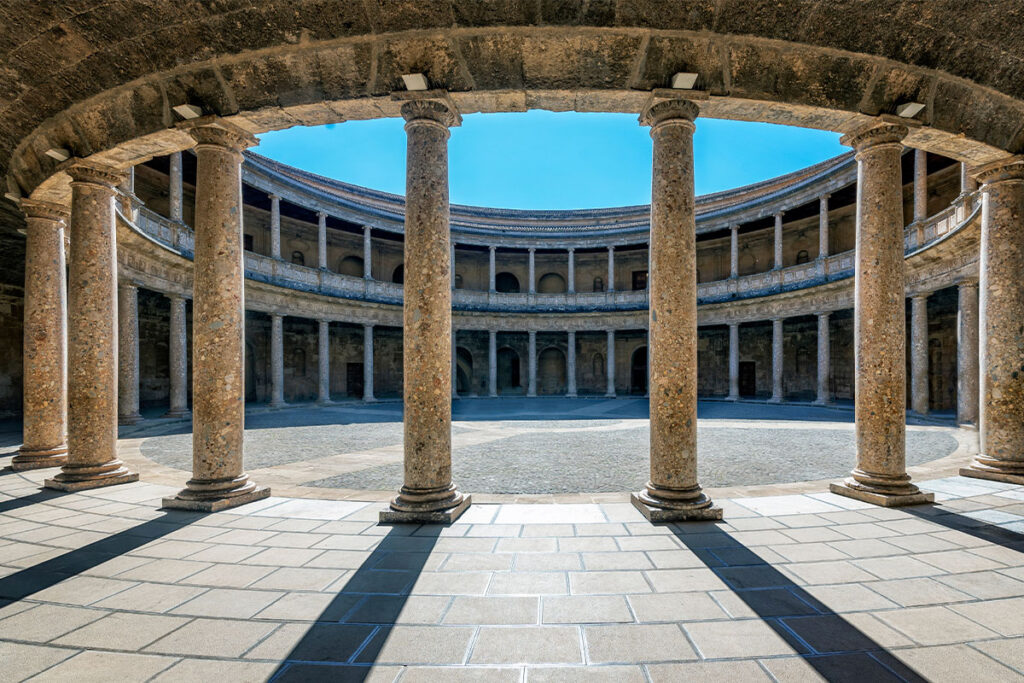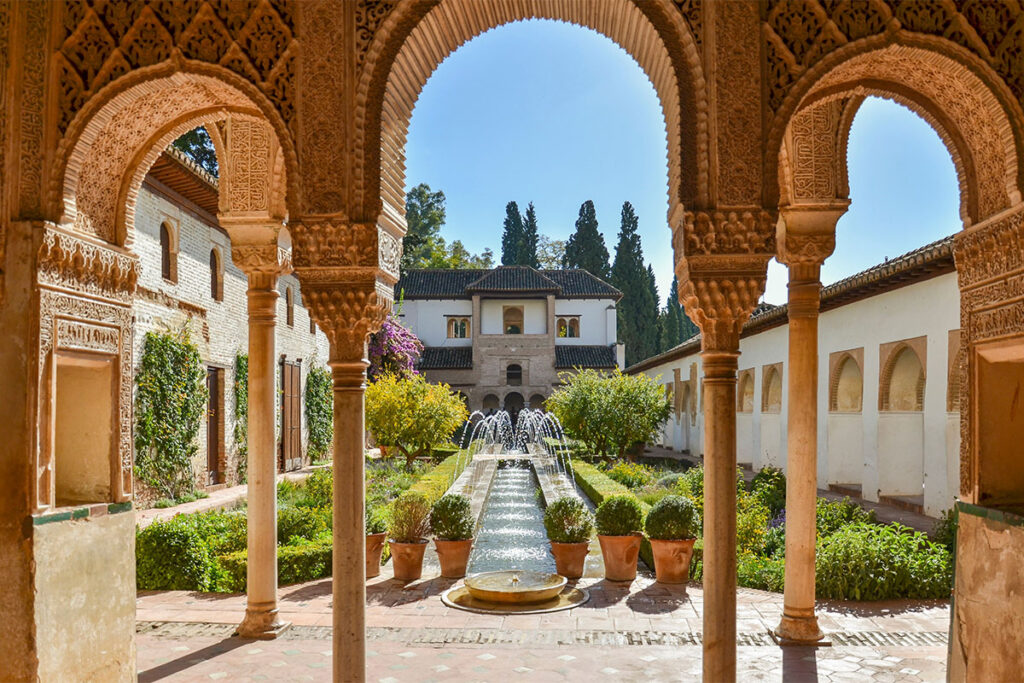If you are wondering where to start exploring Andalusia, this article will dispel all your doubts.
The Alhambra is the most important monument in Granada. This huge castle and palace complex was built in the 13th-14th centuries and is now a symbol of the entire city. It is mainly because of it that Granada is visited by several million tourists a year. Alhambra is a site that is presented to you in every travel guide. It is the most outstanding example of Arab palace architecture in medieval Europe. The snow-capped peaks of the Sierra Nevada, emerging in the background, make it even more charming.
GOOD TO KNOW: At the entrance to the Palace there is the Gate of Justice (Puerta de la Justicia). It was here where disputes between the inhabitants were settled during the times of Muslim domination.
Visiting the Alhambra
How to visit Alhambra? Since the entire complex is really huge, it is worth spending at least a few hours visiting it. The Alhambra consists of several main buildings:
Alcazaba
It is the oldest, most fortified, but also the least phenomenal part of the Alhambra. Most of its buildings are in ruins, which means that only the remains of old buildings, such as bathhouses or apartments, are available to visitors. However, four large towers are in good condition. From the historical perspective, the most important one is Torre de Vela. Its peak was where on 2 January 1492 the flag was planted announcing the victory of the Christian army over the Moors.
GOOD TO KNOW: The Alcazaba is also a great vantage point over the Alhambra and the whole city. From its top, we can also see the silhouette of the nearby Sierra Nevada mountains.
Charles V Palace (Palacio de Carlos V)
Don’t be surprised that this building is one of the most controversial in the whole Alhambra. According to some, it does not match the architecture of the entire complex at all and destroys its order. According to architecture critics, however, when you look at it without paying attention to other buildings, you can say that it is the most magnificent Renaissance palace outside of Italy.
You can form your own opinion about Charles V Palace. What is worth knowing, however, is the reason why its appearance differs from other parts of the Alhambra. To understand this, we must go back to the first half of the 16th century, when King Charles V ordered a residence to be built in the Alhambra. Although it involved the demolition of a part of the Muslim palace, the will of the ruler was fulfilled.

Today, the building has an impressive size. There are over 30 columns in the inner courtyard. The ground floor is occupied by the Alhambra Museum (Museo de la Alhambra), where we can admire exhibits from the times of the Moorish rulers. The most interesting ones include the Jarrón de las Gacelas vase, which dates from the 15th century, measures 1.5 m and is decorated with painstakingly made images of gazelles (hence the name of this exhibit: Gazelle Jug).
INTERESTING FACT: The Charles V Palace was designed by Pedro Machuca, a student of Michelangelo.
Nasrid Palaces (Palacios Nazaríes)
It is said to be the most beautiful part of the Alhambra. It delights visitors with its magnificent courtyards, rich ornamentation and quotes from The Quran appearing here and there (the most famous one is “There is no conqueror above Allah”).
The Nasrid Palaces consist of three complexes:
- Mexuar (Sala del Mexuar) – here commercial and judicial matters were handled. The rulers’ meetings and audiences were also held here. The mihrab (prayer niche) offers a wonderful view of the Albaicín district. The Mexuar is also connected with the Cuarto Dorado (Golden Chamber), where the often repeated inscription “Plus Ultra” will catch your eye. This inscription was added during the reign of Charles V (it was a kind of symbol of this ruler). It is worth adding that we can also find it in the coat of arms of Spain.
- Stained Glass Palace (Palacio de Comares) – according to historians, this is where the official residences of the rulers were located. During the visit, the rectangular swimming pool, located in the heart of the courtyard, draws your attention. From the Stained Glass Palace, we will reach the Torre de Comares – a fortified tower, which houses a huge throne room and the Ambassadors’ Room (Salón de Embajadores).
From a historical point of view, the Stained Glass Palace is an extremely important and unique place. Here, important diplomatic decisions were made. Here, the Arab ruler Boabdil signed the act of surrender of Granada. Finally, it was here where Christopher Columbus persuaded the Catholic kings to support him in organizing an expedition, the aim of which was to find a shorter path to India, which resulted in the discovery of America.
- Palace of Lions (Palacio de los Leones) – this part of the Nasrid Palace served as private residences of the rulers. The Courtyard of the Lions located here is one of the most often photographed places in the Alhambra. What is amazing about it is a beautiful fountain which is supported by twelve statues of lions. The channels that flow from the fountain to the four directions of the world symbolize the four rivers of Islamic paradise. Going north of the courtyard, we will reach the Hall of the Two Sisters (Sala de dos Hermanas). In its vicinity there were rooms for the wives of the rulers.
Other interesting places worth seeing:
- Sala de los Reyes
- Mirador de Daraxa viewpoint
- Sala de los Abencerraje
- Baño de la Mezquita
Generalife Gardens
Everyone needs a break sometimes. It was no different in the case of the Arab rulers who went to the Generalife for this purpose. In the center of this complex you will find the Patio de la Acequia, where the fountains gushing from the long pool are in the centre of all visitors’ attention. Generalife gardens look delightful almost at any time of the year. There are plenty of roses, palms and cypresses (take a walk along Paseo de los Cipreses), which can put even the biggest malcontents in a romantic mood.
INTERESTING FACT: Every June, the Generalife hosts the International Festival of Music and Dance (Festival Internacional de Música y Danza de Granada).
History of the Alhambra Palace
Although the oldest mentions of Alhambra come from the 9th century, at that time was this place mainly a defensive fortress situated on the al-Sabika hill. The real breakthrough came no sooner than in the thirteenth century. Wars between the Christian and Muslim armies led the Moors to gradually leave the northern part of the Iberian Peninsula. Their mainstay was the land of Al-Andaluz, which had been ruled by the Moors for several centuries. One of the cities that was part of it was Granada. Here, too, it was decided to create the largest and most spectacular palace complex ever built in Europe.
INTERESTING FACT: It is believed that one of the oldest structures in the Alhambra is the Puerta del Vino gate.
A city within a city
The construction started in the 13 th century and was initiated by Muhammad I Ibn Yusuf, the first Nasrid ruler. It was clear from the outset that the Alhambra would be more than a palace, castle or fortress. With the advent of subsequent rulers, this place grew to an exorbitant size. It was expanded and modified to best meet the needs of its inhabitants.

Some say it was a city within a city. There were mosques, schools, gardens, baths, swimming pools, cloisters, courtyards, squares, workshops … The royal chambers existed together with the households of residents of not necessarily royal roots. Despite significant social differences, peace and harmony prevailed between the inhabitants of the Alhambra.
Farewell to a fairy tale…
The heyday of the Alhambra ended on 2 January 1492. It was then that Granada was finally conquered by the Christian army of the Reconquista, and the Moors forever lost one of the most precious treasures of their civilization. Unlike many other Muslim buildings that were built in today’s Spain, the Alhambra was fortunately saved from destruction and oblivion. Its beauty and panache impressed even Catholic rulers. So instead of razing this place to the ground, they decided to “enrich” it with a few additional objects that were to be a symbol of Christian power. We are talking about a royal palace, a monastery and a church built on the site of a former mosque.
GOOD TO KNOW: If you are interested in beautiful views, go to the Vigil Tower (Torre de la Vela), which offers a beautiful view of the Alhambra.
Alhambra anew
Despite its enormous grace, the Alhambra began to fall into disrepair in the following centuries. It was evident as soon as in the 17 th century, while two centuries later, during the invasion of Napoleonic troops, it miraculously avoided being blown up!
It was not until the 19th century that more attention was paid to this monument. In 1870, the complex was included in the list of Spanish national monuments. At that time, numerous renovations and restoration of building elements that had been partially or completely destroyed began to be carried out. Finally, in 1984, the Alhambra was inscribed on the UNESCO World Heritage List. Every year, it attracts more and more tourists interested in the history and willing to discover the beauty of this place.
Practical info
- It’s best to buy tickets to the Alhambra in advance. You will then avoid standing in a long queue and avoid the risk that all tickets have been sold out, which happens very often in the case of this monument.
- Address: C. Real de la Alhambra, s/n, 18009 Granada, Spain
- Buy Tickets on GetYourGuide
